Business Environment Report: H&M's Organizational Analysis
VerifiedAdded on 2020/06/03
|16
|5310
|771
Report
AI Summary
This report provides a comprehensive analysis of H&M's business environment, covering various organizational types including public, private, and voluntary sectors. It delves into the size and scope of these organizations, highlighting how their structures relate to business objectives. The report examines the interrelationships between different organizational functions within H&M, discussing their advantages and disadvantages. Furthermore, it explores the positive and negative impacts of macro-environmental factors, utilizing the PESTLE model for a detailed analysis. The study includes an internal and external analysis, incorporating a SWOT analysis to illustrate how strengths, weaknesses, opportunities, and threats influence decision-making within the company. The report concludes with a summary of findings and relevant references.
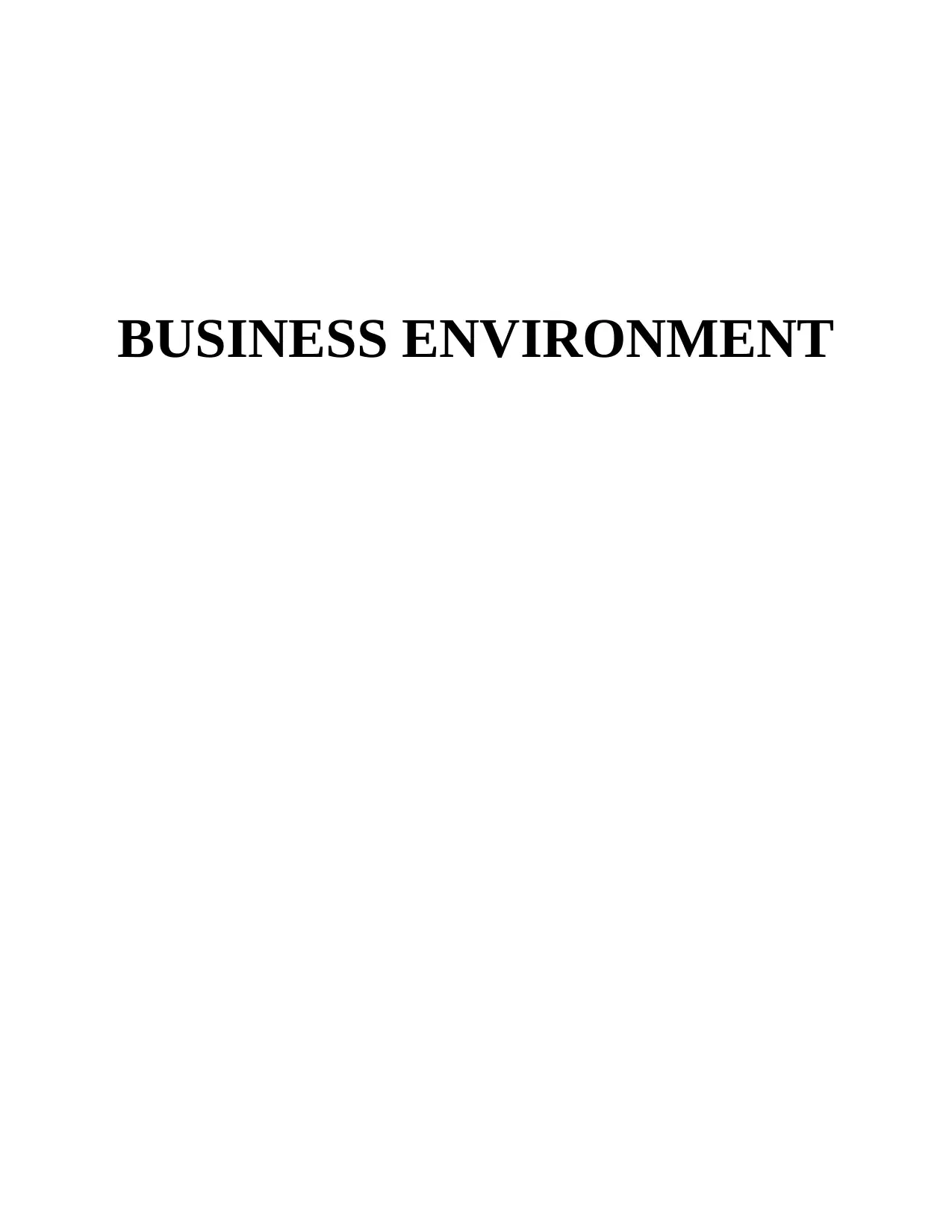
BUSINESS ENVIRONMENT
Paraphrase This Document
Need a fresh take? Get an instant paraphrase of this document with our AI Paraphraser
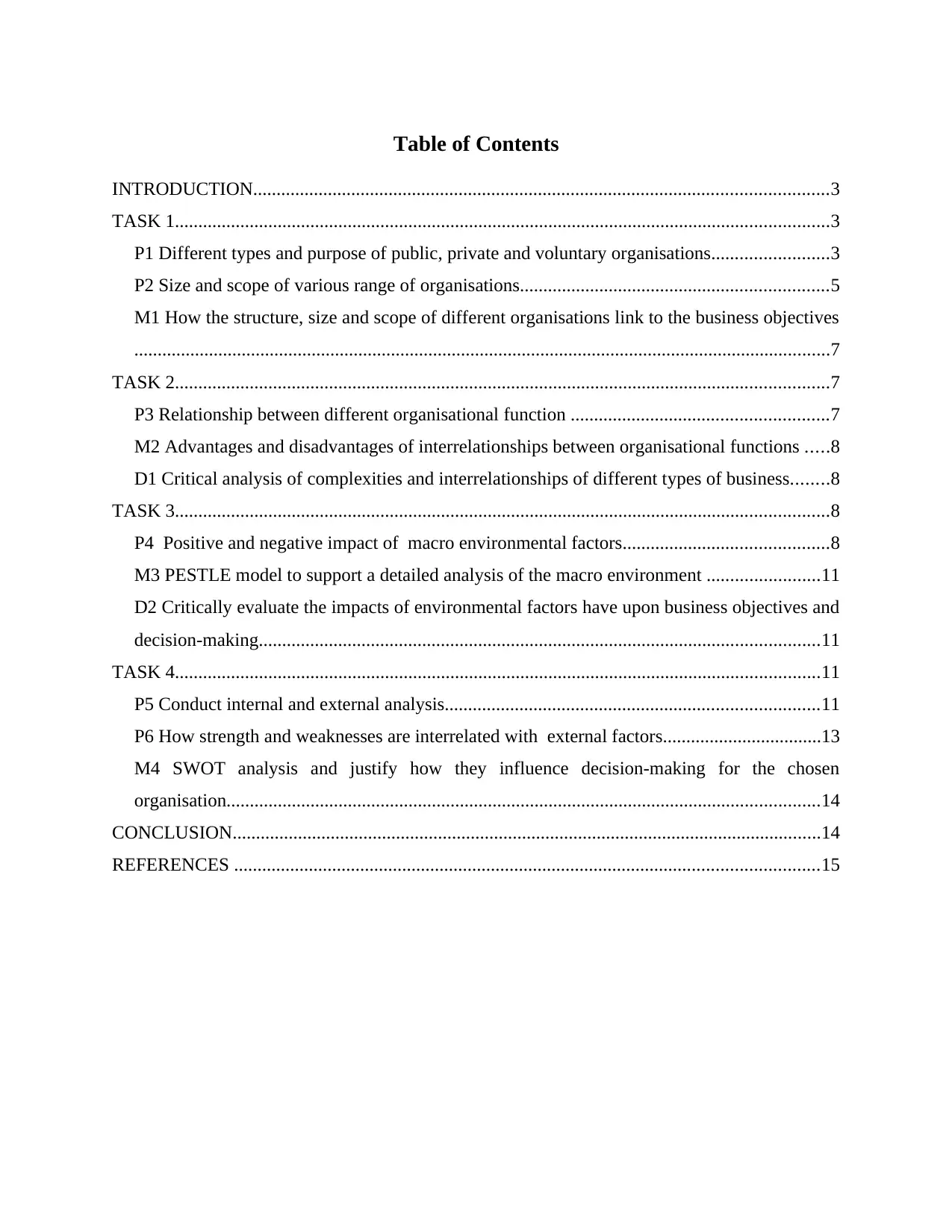
Table of Contents
INTRODUCTION...........................................................................................................................3
TASK 1............................................................................................................................................3
P1 Different types and purpose of public, private and voluntary organisations.........................3
P2 Size and scope of various range of organisations..................................................................5
M1 How the structure, size and scope of different organisations link to the business objectives
.....................................................................................................................................................7
TASK 2............................................................................................................................................7
P3 Relationship between different organisational function .......................................................7
M2 Advantages and disadvantages of interrelationships between organisational functions .....8
D1 Critical analysis of complexities and interrelationships of different types of business........8
TASK 3............................................................................................................................................8
P4 Positive and negative impact of macro environmental factors............................................8
M3 PESTLE model to support a detailed analysis of the macro environment ........................11
D2 Critically evaluate the impacts of environmental factors have upon business objectives and
decision-making........................................................................................................................11
TASK 4..........................................................................................................................................11
P5 Conduct internal and external analysis................................................................................11
P6 How strength and weaknesses are interrelated with external factors..................................13
M4 SWOT analysis and justify how they influence decision-making for the chosen
organisation...............................................................................................................................14
CONCLUSION..............................................................................................................................14
REFERENCES .............................................................................................................................15
INTRODUCTION...........................................................................................................................3
TASK 1............................................................................................................................................3
P1 Different types and purpose of public, private and voluntary organisations.........................3
P2 Size and scope of various range of organisations..................................................................5
M1 How the structure, size and scope of different organisations link to the business objectives
.....................................................................................................................................................7
TASK 2............................................................................................................................................7
P3 Relationship between different organisational function .......................................................7
M2 Advantages and disadvantages of interrelationships between organisational functions .....8
D1 Critical analysis of complexities and interrelationships of different types of business........8
TASK 3............................................................................................................................................8
P4 Positive and negative impact of macro environmental factors............................................8
M3 PESTLE model to support a detailed analysis of the macro environment ........................11
D2 Critically evaluate the impacts of environmental factors have upon business objectives and
decision-making........................................................................................................................11
TASK 4..........................................................................................................................................11
P5 Conduct internal and external analysis................................................................................11
P6 How strength and weaknesses are interrelated with external factors..................................13
M4 SWOT analysis and justify how they influence decision-making for the chosen
organisation...............................................................................................................................14
CONCLUSION..............................................................................................................................14
REFERENCES .............................................................................................................................15
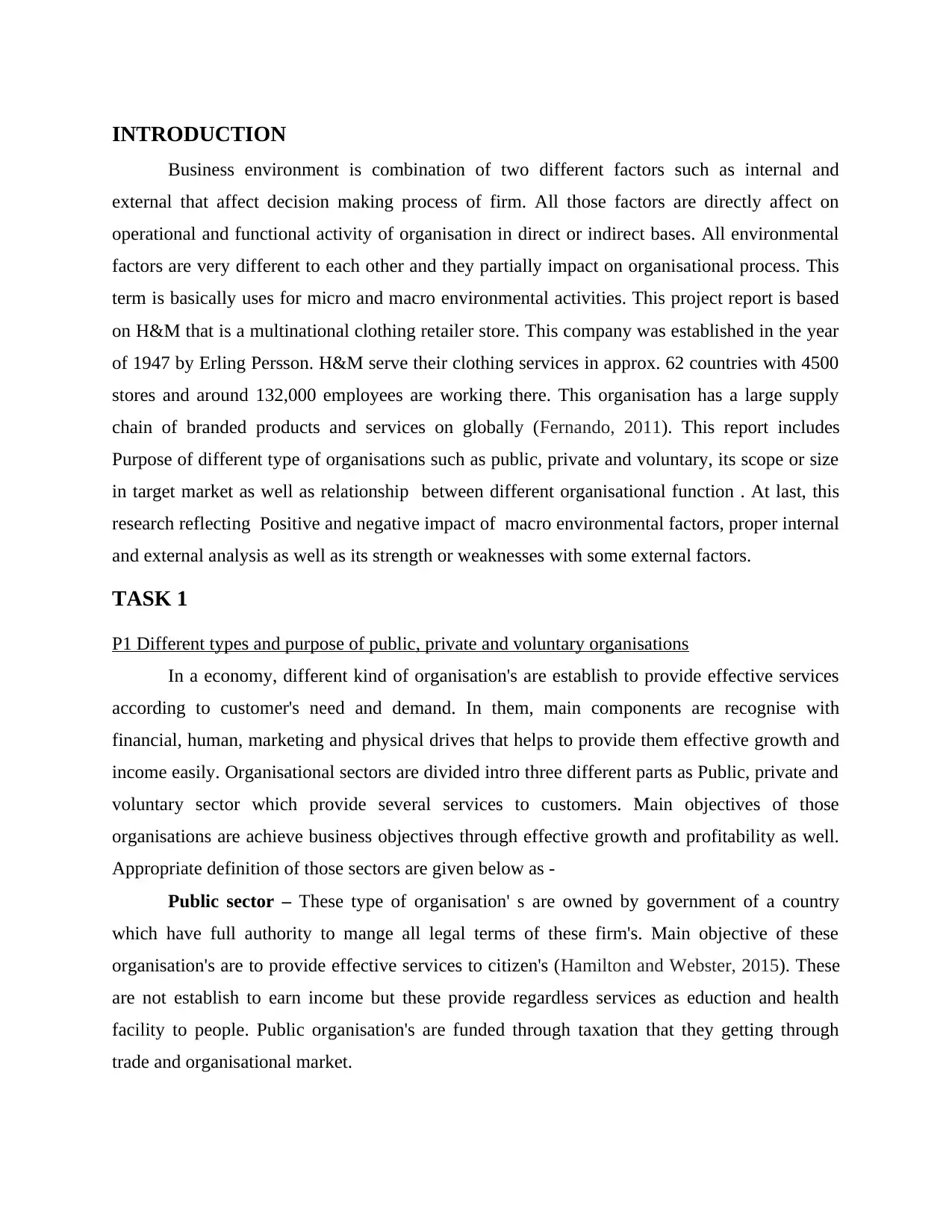
INTRODUCTION
Business environment is combination of two different factors such as internal and
external that affect decision making process of firm. All those factors are directly affect on
operational and functional activity of organisation in direct or indirect bases. All environmental
factors are very different to each other and they partially impact on organisational process. This
term is basically uses for micro and macro environmental activities. This project report is based
on H&M that is a multinational clothing retailer store. This company was established in the year
of 1947 by Erling Persson. H&M serve their clothing services in approx. 62 countries with 4500
stores and around 132,000 employees are working there. This organisation has a large supply
chain of branded products and services on globally (Fernando, 2011). This report includes
Purpose of different type of organisations such as public, private and voluntary, its scope or size
in target market as well as relationship between different organisational function . At last, this
research reflecting Positive and negative impact of macro environmental factors, proper internal
and external analysis as well as its strength or weaknesses with some external factors.
TASK 1
P1 Different types and purpose of public, private and voluntary organisations
In a economy, different kind of organisation's are establish to provide effective services
according to customer's need and demand. In them, main components are recognise with
financial, human, marketing and physical drives that helps to provide them effective growth and
income easily. Organisational sectors are divided intro three different parts as Public, private and
voluntary sector which provide several services to customers. Main objectives of those
organisations are achieve business objectives through effective growth and profitability as well.
Appropriate definition of those sectors are given below as -
Public sector – These type of organisation' s are owned by government of a country
which have full authority to mange all legal terms of these firm's. Main objective of these
organisation's are to provide effective services to citizen's (Hamilton and Webster, 2015). These
are not establish to earn income but these provide regardless services as eduction and health
facility to people. Public organisation's are funded through taxation that they getting through
trade and organisational market.
Business environment is combination of two different factors such as internal and
external that affect decision making process of firm. All those factors are directly affect on
operational and functional activity of organisation in direct or indirect bases. All environmental
factors are very different to each other and they partially impact on organisational process. This
term is basically uses for micro and macro environmental activities. This project report is based
on H&M that is a multinational clothing retailer store. This company was established in the year
of 1947 by Erling Persson. H&M serve their clothing services in approx. 62 countries with 4500
stores and around 132,000 employees are working there. This organisation has a large supply
chain of branded products and services on globally (Fernando, 2011). This report includes
Purpose of different type of organisations such as public, private and voluntary, its scope or size
in target market as well as relationship between different organisational function . At last, this
research reflecting Positive and negative impact of macro environmental factors, proper internal
and external analysis as well as its strength or weaknesses with some external factors.
TASK 1
P1 Different types and purpose of public, private and voluntary organisations
In a economy, different kind of organisation's are establish to provide effective services
according to customer's need and demand. In them, main components are recognise with
financial, human, marketing and physical drives that helps to provide them effective growth and
income easily. Organisational sectors are divided intro three different parts as Public, private and
voluntary sector which provide several services to customers. Main objectives of those
organisations are achieve business objectives through effective growth and profitability as well.
Appropriate definition of those sectors are given below as -
Public sector – These type of organisation' s are owned by government of a country
which have full authority to mange all legal terms of these firm's. Main objective of these
organisation's are to provide effective services to citizen's (Hamilton and Webster, 2015). These
are not establish to earn income but these provide regardless services as eduction and health
facility to people. Public organisation's are funded through taxation that they getting through
trade and organisational market.
⊘ This is a preview!⊘
Do you want full access?
Subscribe today to unlock all pages.

Trusted by 1+ million students worldwide
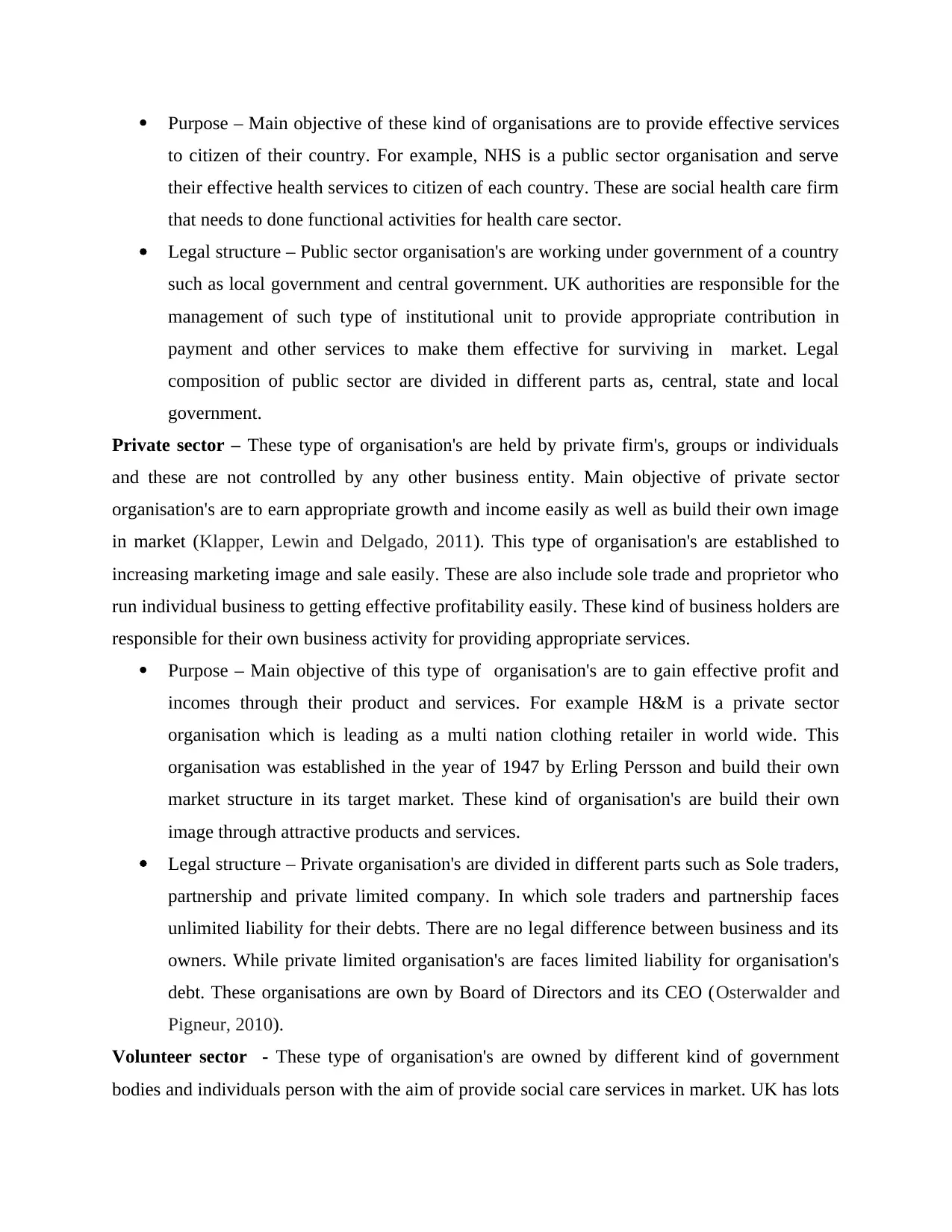
Purpose – Main objective of these kind of organisations are to provide effective services
to citizen of their country. For example, NHS is a public sector organisation and serve
their effective health services to citizen of each country. These are social health care firm
that needs to done functional activities for health care sector.
Legal structure – Public sector organisation's are working under government of a country
such as local government and central government. UK authorities are responsible for the
management of such type of institutional unit to provide appropriate contribution in
payment and other services to make them effective for surviving in market. Legal
composition of public sector are divided in different parts as, central, state and local
government.
Private sector – These type of organisation's are held by private firm's, groups or individuals
and these are not controlled by any other business entity. Main objective of private sector
organisation's are to earn appropriate growth and income easily as well as build their own image
in market (Klapper, Lewin and Delgado, 2011). This type of organisation's are established to
increasing marketing image and sale easily. These are also include sole trade and proprietor who
run individual business to getting effective profitability easily. These kind of business holders are
responsible for their own business activity for providing appropriate services.
Purpose – Main objective of this type of organisation's are to gain effective profit and
incomes through their product and services. For example H&M is a private sector
organisation which is leading as a multi nation clothing retailer in world wide. This
organisation was established in the year of 1947 by Erling Persson and build their own
market structure in its target market. These kind of organisation's are build their own
image through attractive products and services.
Legal structure – Private organisation's are divided in different parts such as Sole traders,
partnership and private limited company. In which sole traders and partnership faces
unlimited liability for their debts. There are no legal difference between business and its
owners. While private limited organisation's are faces limited liability for organisation's
debt. These organisations are own by Board of Directors and its CEO (Osterwalder and
Pigneur, 2010).
Volunteer sector - These type of organisation's are owned by different kind of government
bodies and individuals person with the aim of provide social care services in market. UK has lots
to citizen of their country. For example, NHS is a public sector organisation and serve
their effective health services to citizen of each country. These are social health care firm
that needs to done functional activities for health care sector.
Legal structure – Public sector organisation's are working under government of a country
such as local government and central government. UK authorities are responsible for the
management of such type of institutional unit to provide appropriate contribution in
payment and other services to make them effective for surviving in market. Legal
composition of public sector are divided in different parts as, central, state and local
government.
Private sector – These type of organisation's are held by private firm's, groups or individuals
and these are not controlled by any other business entity. Main objective of private sector
organisation's are to earn appropriate growth and income easily as well as build their own image
in market (Klapper, Lewin and Delgado, 2011). This type of organisation's are established to
increasing marketing image and sale easily. These are also include sole trade and proprietor who
run individual business to getting effective profitability easily. These kind of business holders are
responsible for their own business activity for providing appropriate services.
Purpose – Main objective of this type of organisation's are to gain effective profit and
incomes through their product and services. For example H&M is a private sector
organisation which is leading as a multi nation clothing retailer in world wide. This
organisation was established in the year of 1947 by Erling Persson and build their own
market structure in its target market. These kind of organisation's are build their own
image through attractive products and services.
Legal structure – Private organisation's are divided in different parts such as Sole traders,
partnership and private limited company. In which sole traders and partnership faces
unlimited liability for their debts. There are no legal difference between business and its
owners. While private limited organisation's are faces limited liability for organisation's
debt. These organisations are own by Board of Directors and its CEO (Osterwalder and
Pigneur, 2010).
Volunteer sector - These type of organisation's are owned by different kind of government
bodies and individuals person with the aim of provide social care services in market. UK has lots
Paraphrase This Document
Need a fresh take? Get an instant paraphrase of this document with our AI Paraphraser
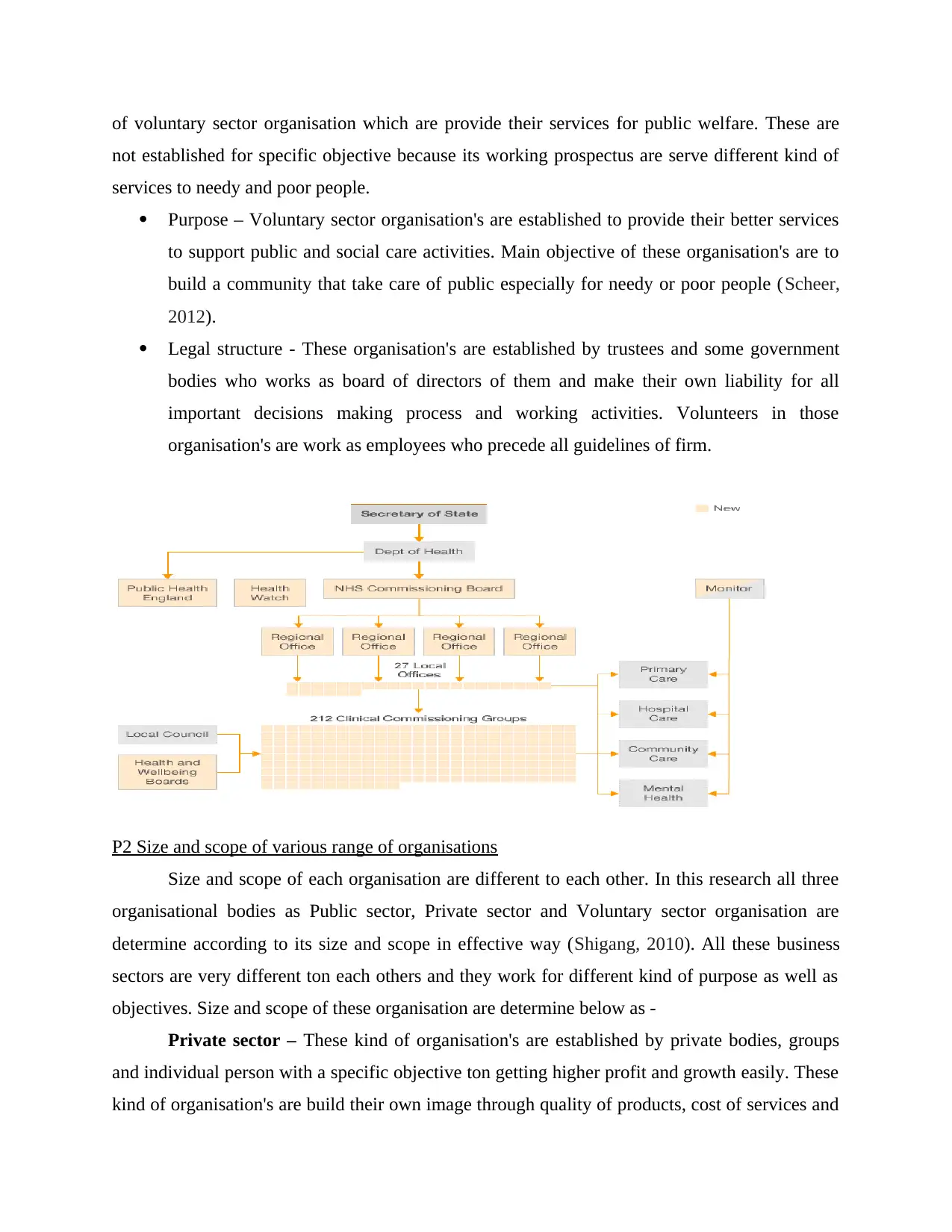
of voluntary sector organisation which are provide their services for public welfare. These are
not established for specific objective because its working prospectus are serve different kind of
services to needy and poor people.
Purpose – Voluntary sector organisation's are established to provide their better services
to support public and social care activities. Main objective of these organisation's are to
build a community that take care of public especially for needy or poor people (Scheer,
2012).
Legal structure - These organisation's are established by trustees and some government
bodies who works as board of directors of them and make their own liability for all
important decisions making process and working activities. Volunteers in those
organisation's are work as employees who precede all guidelines of firm.
P2 Size and scope of various range of organisations
Size and scope of each organisation are different to each other. In this research all three
organisational bodies as Public sector, Private sector and Voluntary sector organisation are
determine according to its size and scope in effective way (Shigang, 2010). All these business
sectors are very different ton each others and they work for different kind of purpose as well as
objectives. Size and scope of these organisation are determine below as -
Private sector – These kind of organisation's are established by private bodies, groups
and individual person with a specific objective ton getting higher profit and growth easily. These
kind of organisation's are build their own image through quality of products, cost of services and
not established for specific objective because its working prospectus are serve different kind of
services to needy and poor people.
Purpose – Voluntary sector organisation's are established to provide their better services
to support public and social care activities. Main objective of these organisation's are to
build a community that take care of public especially for needy or poor people (Scheer,
2012).
Legal structure - These organisation's are established by trustees and some government
bodies who works as board of directors of them and make their own liability for all
important decisions making process and working activities. Volunteers in those
organisation's are work as employees who precede all guidelines of firm.
P2 Size and scope of various range of organisations
Size and scope of each organisation are different to each other. In this research all three
organisational bodies as Public sector, Private sector and Voluntary sector organisation are
determine according to its size and scope in effective way (Shigang, 2010). All these business
sectors are very different ton each others and they work for different kind of purpose as well as
objectives. Size and scope of these organisation are determine below as -
Private sector – These kind of organisation's are established by private bodies, groups
and individual person with a specific objective ton getting higher profit and growth easily. These
kind of organisation's are build their own image through quality of products, cost of services and
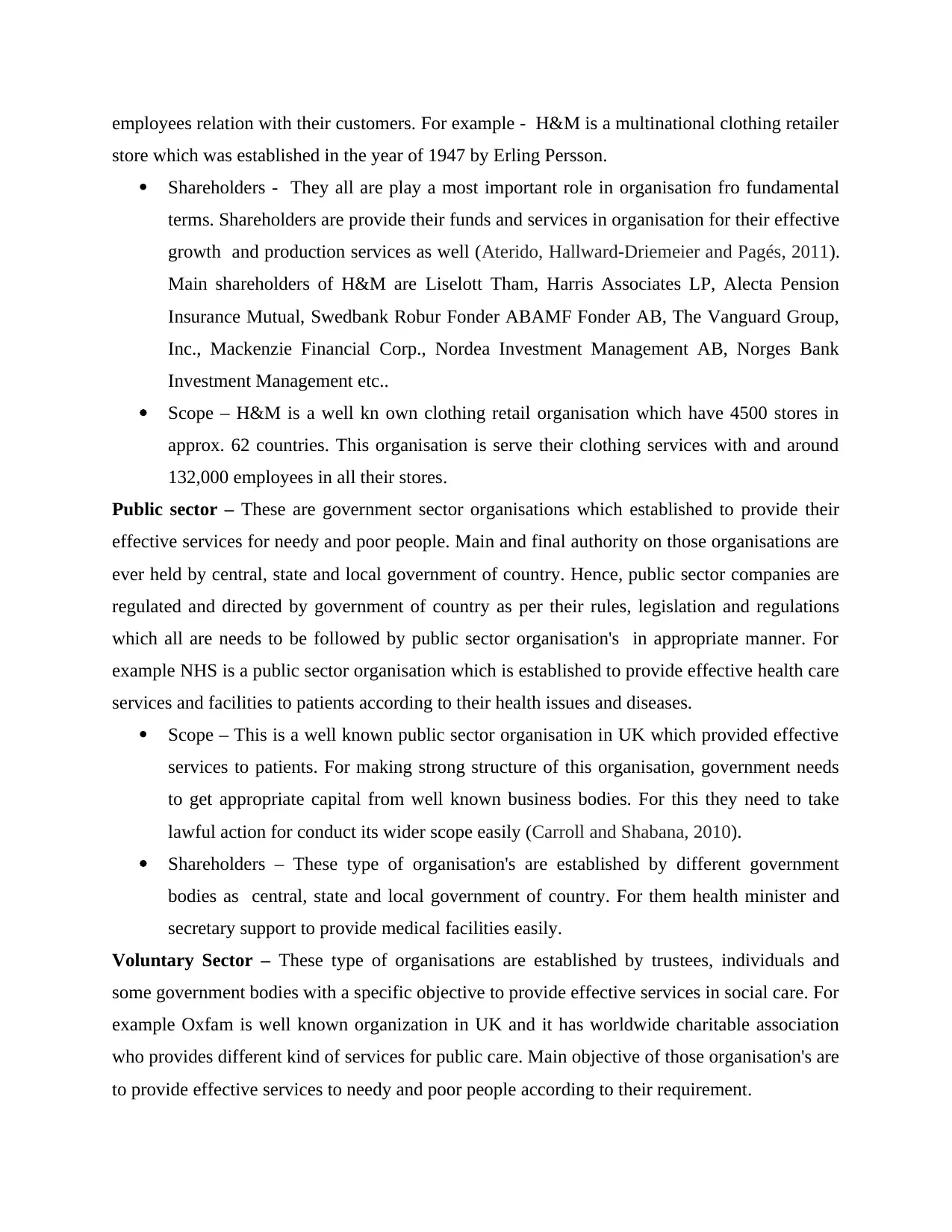
employees relation with their customers. For example - H&M is a multinational clothing retailer
store which was established in the year of 1947 by Erling Persson.
Shareholders - They all are play a most important role in organisation fro fundamental
terms. Shareholders are provide their funds and services in organisation for their effective
growth and production services as well (Aterido, Hallward-Driemeier and Pagés, 2011).
Main shareholders of H&M are Liselott Tham, Harris Associates LP, Alecta Pension
Insurance Mutual, Swedbank Robur Fonder ABAMF Fonder AB, The Vanguard Group,
Inc., Mackenzie Financial Corp., Nordea Investment Management AB, Norges Bank
Investment Management etc..
Scope – H&M is a well kn own clothing retail organisation which have 4500 stores in
approx. 62 countries. This organisation is serve their clothing services with and around
132,000 employees in all their stores.
Public sector – These are government sector organisations which established to provide their
effective services for needy and poor people. Main and final authority on those organisations are
ever held by central, state and local government of country. Hence, public sector companies are
regulated and directed by government of country as per their rules, legislation and regulations
which all are needs to be followed by public sector organisation's in appropriate manner. For
example NHS is a public sector organisation which is established to provide effective health care
services and facilities to patients according to their health issues and diseases.
Scope – This is a well known public sector organisation in UK which provided effective
services to patients. For making strong structure of this organisation, government needs
to get appropriate capital from well known business bodies. For this they need to take
lawful action for conduct its wider scope easily (Carroll and Shabana, 2010).
Shareholders – These type of organisation's are established by different government
bodies as central, state and local government of country. For them health minister and
secretary support to provide medical facilities easily.
Voluntary Sector – These type of organisations are established by trustees, individuals and
some government bodies with a specific objective to provide effective services in social care. For
example Oxfam is well known organization in UK and it has worldwide charitable association
who provides different kind of services for public care. Main objective of those organisation's are
to provide effective services to needy and poor people according to their requirement.
store which was established in the year of 1947 by Erling Persson.
Shareholders - They all are play a most important role in organisation fro fundamental
terms. Shareholders are provide their funds and services in organisation for their effective
growth and production services as well (Aterido, Hallward-Driemeier and Pagés, 2011).
Main shareholders of H&M are Liselott Tham, Harris Associates LP, Alecta Pension
Insurance Mutual, Swedbank Robur Fonder ABAMF Fonder AB, The Vanguard Group,
Inc., Mackenzie Financial Corp., Nordea Investment Management AB, Norges Bank
Investment Management etc..
Scope – H&M is a well kn own clothing retail organisation which have 4500 stores in
approx. 62 countries. This organisation is serve their clothing services with and around
132,000 employees in all their stores.
Public sector – These are government sector organisations which established to provide their
effective services for needy and poor people. Main and final authority on those organisations are
ever held by central, state and local government of country. Hence, public sector companies are
regulated and directed by government of country as per their rules, legislation and regulations
which all are needs to be followed by public sector organisation's in appropriate manner. For
example NHS is a public sector organisation which is established to provide effective health care
services and facilities to patients according to their health issues and diseases.
Scope – This is a well known public sector organisation in UK which provided effective
services to patients. For making strong structure of this organisation, government needs
to get appropriate capital from well known business bodies. For this they need to take
lawful action for conduct its wider scope easily (Carroll and Shabana, 2010).
Shareholders – These type of organisation's are established by different government
bodies as central, state and local government of country. For them health minister and
secretary support to provide medical facilities easily.
Voluntary Sector – These type of organisations are established by trustees, individuals and
some government bodies with a specific objective to provide effective services in social care. For
example Oxfam is well known organization in UK and it has worldwide charitable association
who provides different kind of services for public care. Main objective of those organisation's are
to provide effective services to needy and poor people according to their requirement.
⊘ This is a preview!⊘
Do you want full access?
Subscribe today to unlock all pages.

Trusted by 1+ million students worldwide
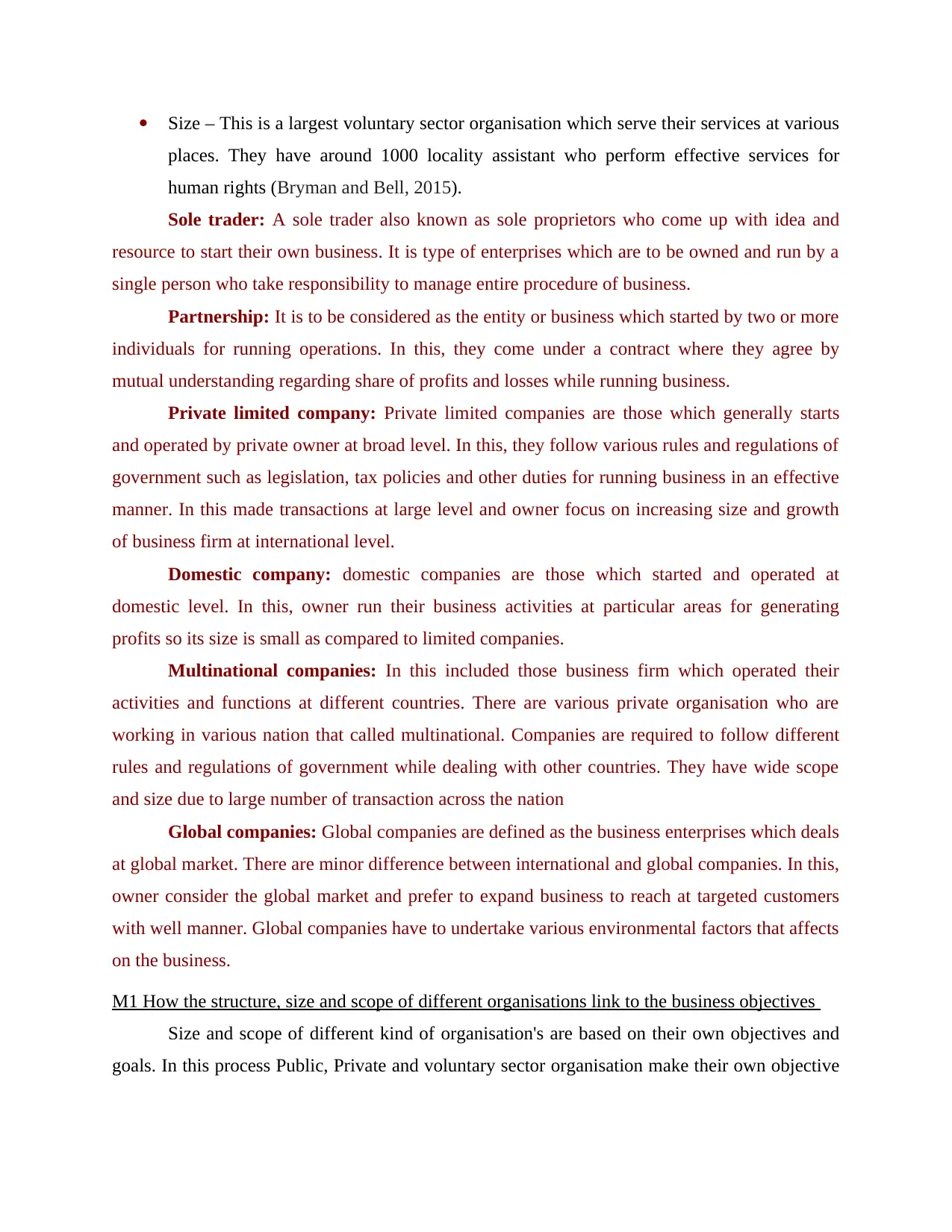
Size – This is a largest voluntary sector organisation which serve their services at various
places. They have around 1000 locality assistant who perform effective services for
human rights (Bryman and Bell, 2015).
Sole trader: A sole trader also known as sole proprietors who come up with idea and
resource to start their own business. It is type of enterprises which are to be owned and run by a
single person who take responsibility to manage entire procedure of business.
Partnership: It is to be considered as the entity or business which started by two or more
individuals for running operations. In this, they come under a contract where they agree by
mutual understanding regarding share of profits and losses while running business.
Private limited company: Private limited companies are those which generally starts
and operated by private owner at broad level. In this, they follow various rules and regulations of
government such as legislation, tax policies and other duties for running business in an effective
manner. In this made transactions at large level and owner focus on increasing size and growth
of business firm at international level.
Domestic company: domestic companies are those which started and operated at
domestic level. In this, owner run their business activities at particular areas for generating
profits so its size is small as compared to limited companies.
Multinational companies: In this included those business firm which operated their
activities and functions at different countries. There are various private organisation who are
working in various nation that called multinational. Companies are required to follow different
rules and regulations of government while dealing with other countries. They have wide scope
and size due to large number of transaction across the nation
Global companies: Global companies are defined as the business enterprises which deals
at global market. There are minor difference between international and global companies. In this,
owner consider the global market and prefer to expand business to reach at targeted customers
with well manner. Global companies have to undertake various environmental factors that affects
on the business.
M1 How the structure, size and scope of different organisations link to the business objectives
Size and scope of different kind of organisation's are based on their own objectives and
goals. In this process Public, Private and voluntary sector organisation make their own objective
places. They have around 1000 locality assistant who perform effective services for
human rights (Bryman and Bell, 2015).
Sole trader: A sole trader also known as sole proprietors who come up with idea and
resource to start their own business. It is type of enterprises which are to be owned and run by a
single person who take responsibility to manage entire procedure of business.
Partnership: It is to be considered as the entity or business which started by two or more
individuals for running operations. In this, they come under a contract where they agree by
mutual understanding regarding share of profits and losses while running business.
Private limited company: Private limited companies are those which generally starts
and operated by private owner at broad level. In this, they follow various rules and regulations of
government such as legislation, tax policies and other duties for running business in an effective
manner. In this made transactions at large level and owner focus on increasing size and growth
of business firm at international level.
Domestic company: domestic companies are those which started and operated at
domestic level. In this, owner run their business activities at particular areas for generating
profits so its size is small as compared to limited companies.
Multinational companies: In this included those business firm which operated their
activities and functions at different countries. There are various private organisation who are
working in various nation that called multinational. Companies are required to follow different
rules and regulations of government while dealing with other countries. They have wide scope
and size due to large number of transaction across the nation
Global companies: Global companies are defined as the business enterprises which deals
at global market. There are minor difference between international and global companies. In this,
owner consider the global market and prefer to expand business to reach at targeted customers
with well manner. Global companies have to undertake various environmental factors that affects
on the business.
M1 How the structure, size and scope of different organisations link to the business objectives
Size and scope of different kind of organisation's are based on their own objectives and
goals. In this process Public, Private and voluntary sector organisation make their own objective
Paraphrase This Document
Need a fresh take? Get an instant paraphrase of this document with our AI Paraphraser
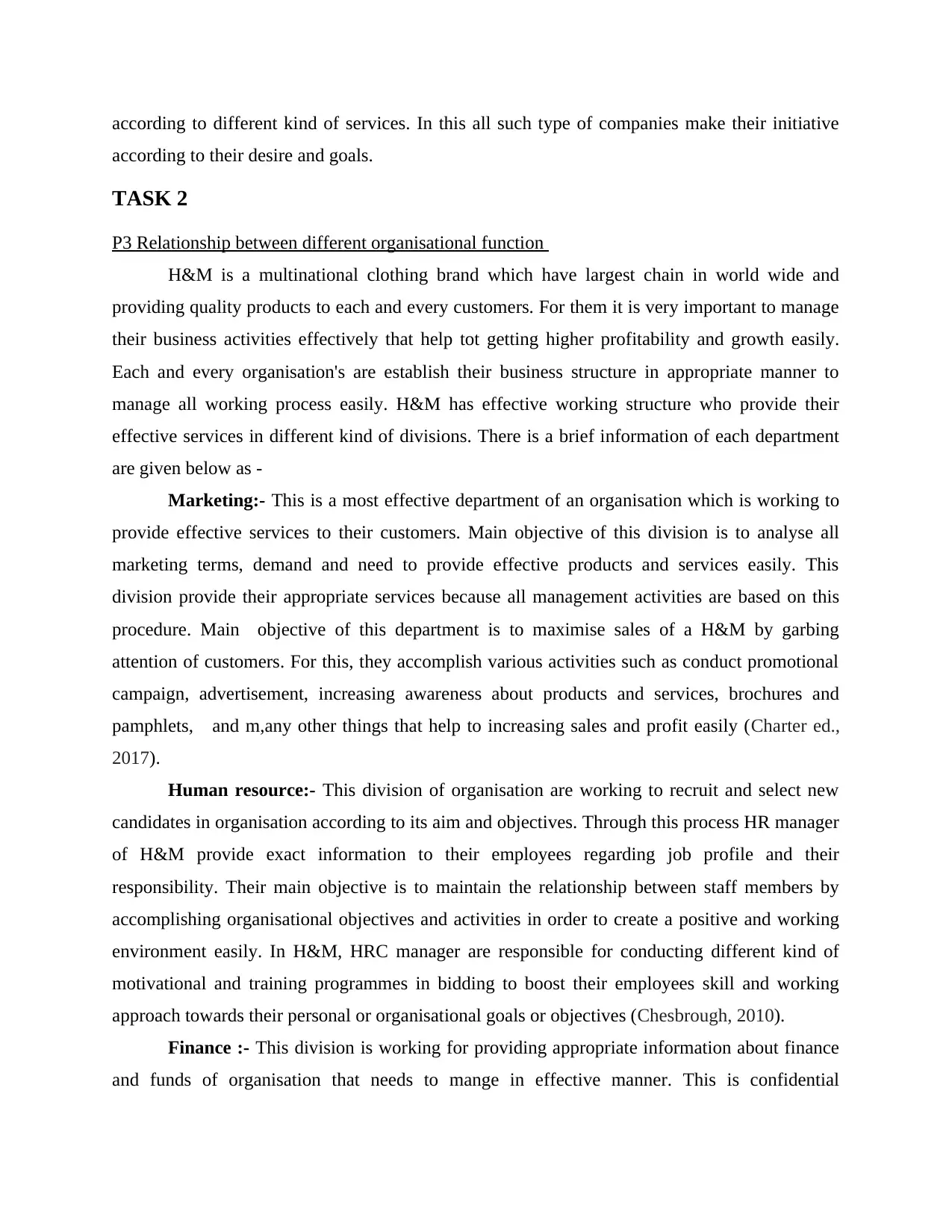
according to different kind of services. In this all such type of companies make their initiative
according to their desire and goals.
TASK 2
P3 Relationship between different organisational function
H&M is a multinational clothing brand which have largest chain in world wide and
providing quality products to each and every customers. For them it is very important to manage
their business activities effectively that help tot getting higher profitability and growth easily.
Each and every organisation's are establish their business structure in appropriate manner to
manage all working process easily. H&M has effective working structure who provide their
effective services in different kind of divisions. There is a brief information of each department
are given below as -
Marketing:- This is a most effective department of an organisation which is working to
provide effective services to their customers. Main objective of this division is to analyse all
marketing terms, demand and need to provide effective products and services easily. This
division provide their appropriate services because all management activities are based on this
procedure. Main objective of this department is to maximise sales of a H&M by garbing
attention of customers. For this, they accomplish various activities such as conduct promotional
campaign, advertisement, increasing awareness about products and services, brochures and
pamphlets, and m,any other things that help to increasing sales and profit easily (Charter ed.,
2017).
Human resource:- This division of organisation are working to recruit and select new
candidates in organisation according to its aim and objectives. Through this process HR manager
of H&M provide exact information to their employees regarding job profile and their
responsibility. Their main objective is to maintain the relationship between staff members by
accomplishing organisational objectives and activities in order to create a positive and working
environment easily. In H&M, HRC manager are responsible for conducting different kind of
motivational and training programmes in bidding to boost their employees skill and working
approach towards their personal or organisational goals or objectives (Chesbrough, 2010).
Finance :- This division is working for providing appropriate information about finance
and funds of organisation that needs to mange in effective manner. This is confidential
according to their desire and goals.
TASK 2
P3 Relationship between different organisational function
H&M is a multinational clothing brand which have largest chain in world wide and
providing quality products to each and every customers. For them it is very important to manage
their business activities effectively that help tot getting higher profitability and growth easily.
Each and every organisation's are establish their business structure in appropriate manner to
manage all working process easily. H&M has effective working structure who provide their
effective services in different kind of divisions. There is a brief information of each department
are given below as -
Marketing:- This is a most effective department of an organisation which is working to
provide effective services to their customers. Main objective of this division is to analyse all
marketing terms, demand and need to provide effective products and services easily. This
division provide their appropriate services because all management activities are based on this
procedure. Main objective of this department is to maximise sales of a H&M by garbing
attention of customers. For this, they accomplish various activities such as conduct promotional
campaign, advertisement, increasing awareness about products and services, brochures and
pamphlets, and m,any other things that help to increasing sales and profit easily (Charter ed.,
2017).
Human resource:- This division of organisation are working to recruit and select new
candidates in organisation according to its aim and objectives. Through this process HR manager
of H&M provide exact information to their employees regarding job profile and their
responsibility. Their main objective is to maintain the relationship between staff members by
accomplishing organisational objectives and activities in order to create a positive and working
environment easily. In H&M, HRC manager are responsible for conducting different kind of
motivational and training programmes in bidding to boost their employees skill and working
approach towards their personal or organisational goals or objectives (Chesbrough, 2010).
Finance :- This division is working for providing appropriate information about finance
and funds of organisation that needs to mange in effective manner. This is confidential
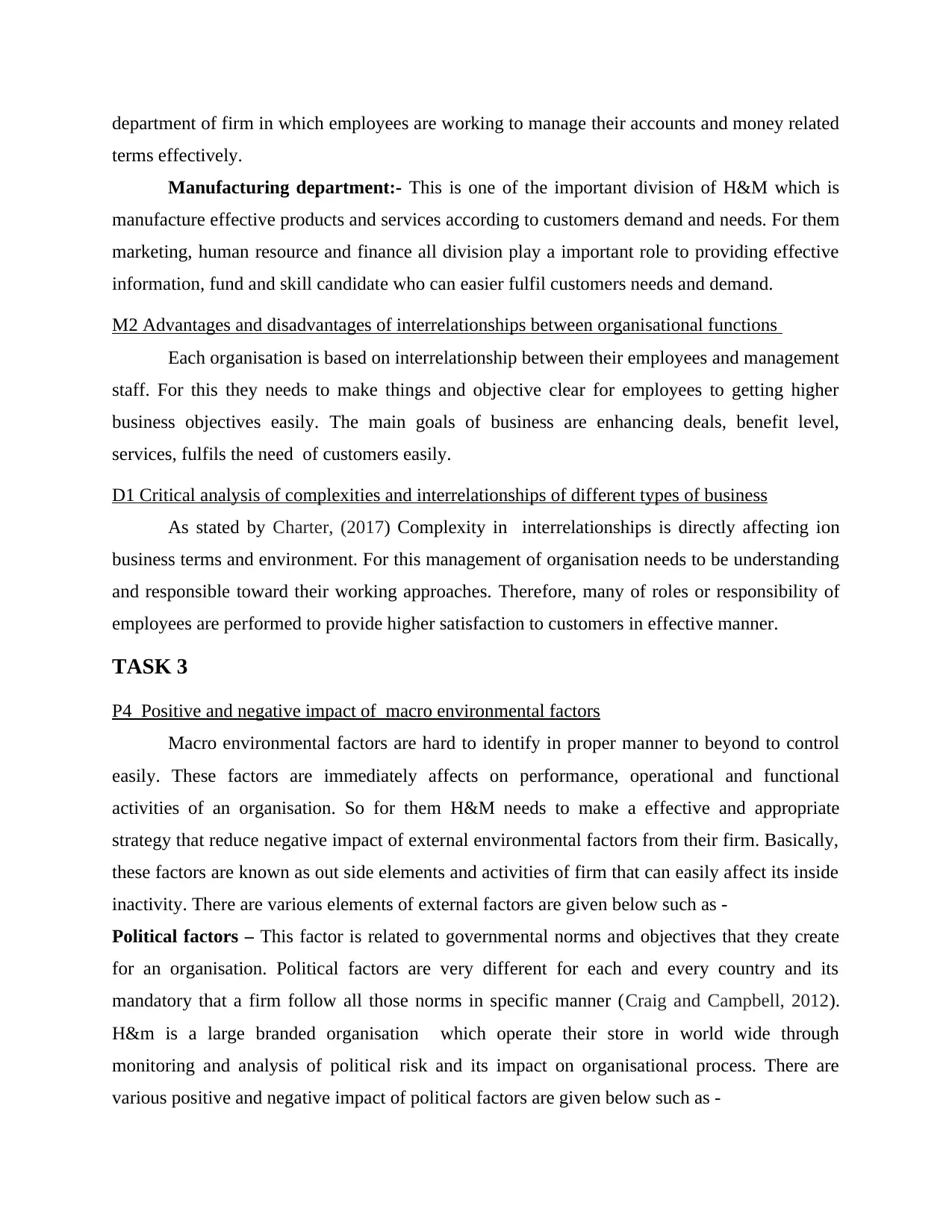
department of firm in which employees are working to manage their accounts and money related
terms effectively.
Manufacturing department:- This is one of the important division of H&M which is
manufacture effective products and services according to customers demand and needs. For them
marketing, human resource and finance all division play a important role to providing effective
information, fund and skill candidate who can easier fulfil customers needs and demand.
M2 Advantages and disadvantages of interrelationships between organisational functions
Each organisation is based on interrelationship between their employees and management
staff. For this they needs to make things and objective clear for employees to getting higher
business objectives easily. The main goals of business are enhancing deals, benefit level,
services, fulfils the need of customers easily.
D1 Critical analysis of complexities and interrelationships of different types of business
As stated by Charter, (2017) Complexity in interrelationships is directly affecting ion
business terms and environment. For this management of organisation needs to be understanding
and responsible toward their working approaches. Therefore, many of roles or responsibility of
employees are performed to provide higher satisfaction to customers in effective manner.
TASK 3
P4 Positive and negative impact of macro environmental factors
Macro environmental factors are hard to identify in proper manner to beyond to control
easily. These factors are immediately affects on performance, operational and functional
activities of an organisation. So for them H&M needs to make a effective and appropriate
strategy that reduce negative impact of external environmental factors from their firm. Basically,
these factors are known as out side elements and activities of firm that can easily affect its inside
inactivity. There are various elements of external factors are given below such as -
Political factors – This factor is related to governmental norms and objectives that they create
for an organisation. Political factors are very different for each and every country and its
mandatory that a firm follow all those norms in specific manner (Craig and Campbell, 2012).
H&m is a large branded organisation which operate their store in world wide through
monitoring and analysis of political risk and its impact on organisational process. There are
various positive and negative impact of political factors are given below such as -
terms effectively.
Manufacturing department:- This is one of the important division of H&M which is
manufacture effective products and services according to customers demand and needs. For them
marketing, human resource and finance all division play a important role to providing effective
information, fund and skill candidate who can easier fulfil customers needs and demand.
M2 Advantages and disadvantages of interrelationships between organisational functions
Each organisation is based on interrelationship between their employees and management
staff. For this they needs to make things and objective clear for employees to getting higher
business objectives easily. The main goals of business are enhancing deals, benefit level,
services, fulfils the need of customers easily.
D1 Critical analysis of complexities and interrelationships of different types of business
As stated by Charter, (2017) Complexity in interrelationships is directly affecting ion
business terms and environment. For this management of organisation needs to be understanding
and responsible toward their working approaches. Therefore, many of roles or responsibility of
employees are performed to provide higher satisfaction to customers in effective manner.
TASK 3
P4 Positive and negative impact of macro environmental factors
Macro environmental factors are hard to identify in proper manner to beyond to control
easily. These factors are immediately affects on performance, operational and functional
activities of an organisation. So for them H&M needs to make a effective and appropriate
strategy that reduce negative impact of external environmental factors from their firm. Basically,
these factors are known as out side elements and activities of firm that can easily affect its inside
inactivity. There are various elements of external factors are given below such as -
Political factors – This factor is related to governmental norms and objectives that they create
for an organisation. Political factors are very different for each and every country and its
mandatory that a firm follow all those norms in specific manner (Craig and Campbell, 2012).
H&m is a large branded organisation which operate their store in world wide through
monitoring and analysis of political risk and its impact on organisational process. There are
various positive and negative impact of political factors are given below such as -
⊘ This is a preview!⊘
Do you want full access?
Subscribe today to unlock all pages.

Trusted by 1+ million students worldwide
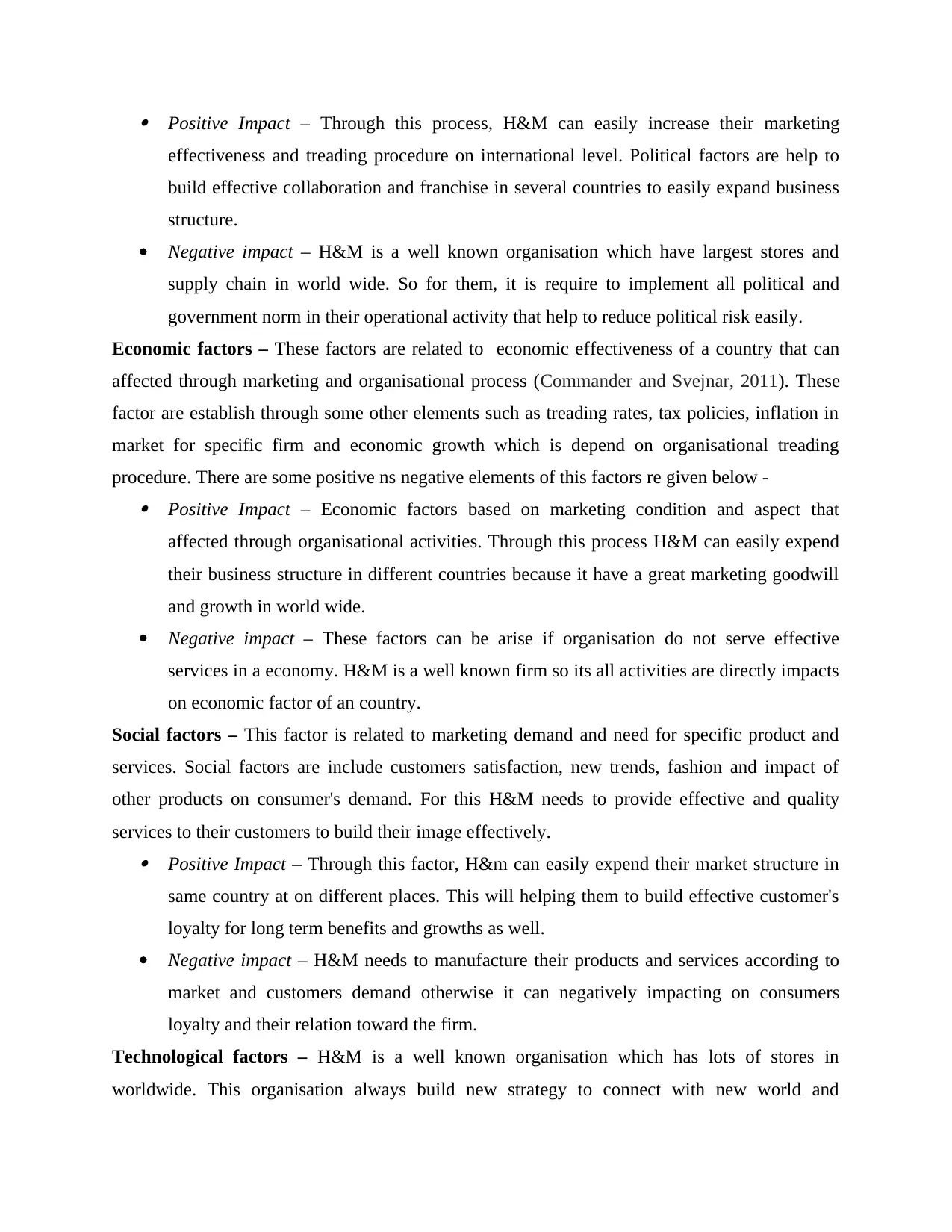
Positive Impact – Through this process, H&M can easily increase their marketing
effectiveness and treading procedure on international level. Political factors are help to
build effective collaboration and franchise in several countries to easily expand business
structure.
Negative impact – H&M is a well known organisation which have largest stores and
supply chain in world wide. So for them, it is require to implement all political and
government norm in their operational activity that help to reduce political risk easily.
Economic factors – These factors are related to economic effectiveness of a country that can
affected through marketing and organisational process (Commander and Svejnar, 2011). These
factor are establish through some other elements such as treading rates, tax policies, inflation in
market for specific firm and economic growth which is depend on organisational treading
procedure. There are some positive ns negative elements of this factors re given below - Positive Impact – Economic factors based on marketing condition and aspect that
affected through organisational activities. Through this process H&M can easily expend
their business structure in different countries because it have a great marketing goodwill
and growth in world wide.
Negative impact – These factors can be arise if organisation do not serve effective
services in a economy. H&M is a well known firm so its all activities are directly impacts
on economic factor of an country.
Social factors – This factor is related to marketing demand and need for specific product and
services. Social factors are include customers satisfaction, new trends, fashion and impact of
other products on consumer's demand. For this H&M needs to provide effective and quality
services to their customers to build their image effectively. Positive Impact – Through this factor, H&m can easily expend their market structure in
same country at on different places. This will helping them to build effective customer's
loyalty for long term benefits and growths as well.
Negative impact – H&M needs to manufacture their products and services according to
market and customers demand otherwise it can negatively impacting on consumers
loyalty and their relation toward the firm.
Technological factors – H&M is a well known organisation which has lots of stores in
worldwide. This organisation always build new strategy to connect with new world and
effectiveness and treading procedure on international level. Political factors are help to
build effective collaboration and franchise in several countries to easily expand business
structure.
Negative impact – H&M is a well known organisation which have largest stores and
supply chain in world wide. So for them, it is require to implement all political and
government norm in their operational activity that help to reduce political risk easily.
Economic factors – These factors are related to economic effectiveness of a country that can
affected through marketing and organisational process (Commander and Svejnar, 2011). These
factor are establish through some other elements such as treading rates, tax policies, inflation in
market for specific firm and economic growth which is depend on organisational treading
procedure. There are some positive ns negative elements of this factors re given below - Positive Impact – Economic factors based on marketing condition and aspect that
affected through organisational activities. Through this process H&M can easily expend
their business structure in different countries because it have a great marketing goodwill
and growth in world wide.
Negative impact – These factors can be arise if organisation do not serve effective
services in a economy. H&M is a well known firm so its all activities are directly impacts
on economic factor of an country.
Social factors – This factor is related to marketing demand and need for specific product and
services. Social factors are include customers satisfaction, new trends, fashion and impact of
other products on consumer's demand. For this H&M needs to provide effective and quality
services to their customers to build their image effectively. Positive Impact – Through this factor, H&m can easily expend their market structure in
same country at on different places. This will helping them to build effective customer's
loyalty for long term benefits and growths as well.
Negative impact – H&M needs to manufacture their products and services according to
market and customers demand otherwise it can negatively impacting on consumers
loyalty and their relation toward the firm.
Technological factors – H&M is a well known organisation which has lots of stores in
worldwide. This organisation always build new strategy to connect with new world and
Paraphrase This Document
Need a fresh take? Get an instant paraphrase of this document with our AI Paraphraser
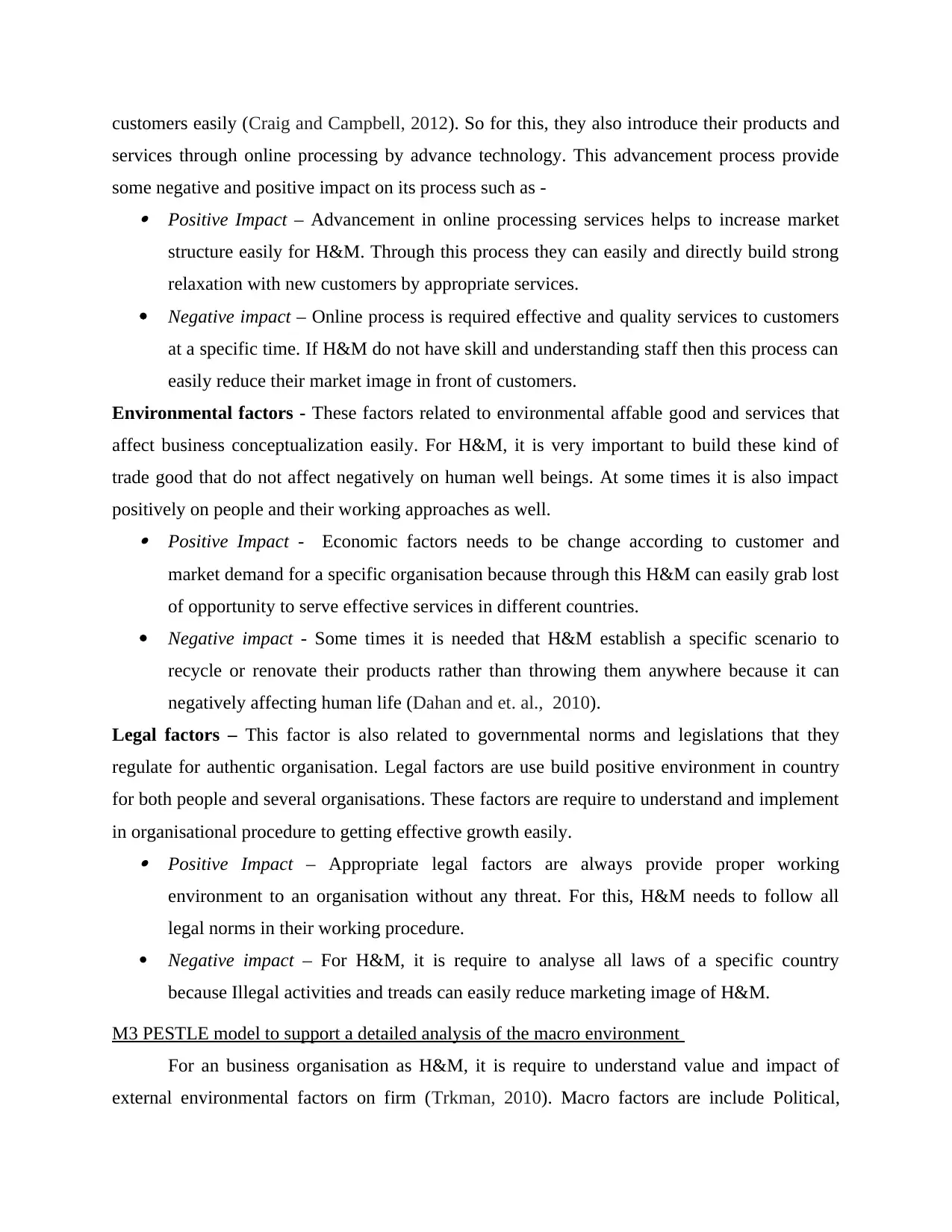
customers easily (Craig and Campbell, 2012). So for this, they also introduce their products and
services through online processing by advance technology. This advancement process provide
some negative and positive impact on its process such as - Positive Impact – Advancement in online processing services helps to increase market
structure easily for H&M. Through this process they can easily and directly build strong
relaxation with new customers by appropriate services.
Negative impact – Online process is required effective and quality services to customers
at a specific time. If H&M do not have skill and understanding staff then this process can
easily reduce their market image in front of customers.
Environmental factors - These factors related to environmental affable good and services that
affect business conceptualization easily. For H&M, it is very important to build these kind of
trade good that do not affect negatively on human well beings. At some times it is also impact
positively on people and their working approaches as well. Positive Impact - Economic factors needs to be change according to customer and
market demand for a specific organisation because through this H&M can easily grab lost
of opportunity to serve effective services in different countries.
Negative impact - Some times it is needed that H&M establish a specific scenario to
recycle or renovate their products rather than throwing them anywhere because it can
negatively affecting human life (Dahan and et. al., 2010).
Legal factors – This factor is also related to governmental norms and legislations that they
regulate for authentic organisation. Legal factors are use build positive environment in country
for both people and several organisations. These factors are require to understand and implement
in organisational procedure to getting effective growth easily. Positive Impact – Appropriate legal factors are always provide proper working
environment to an organisation without any threat. For this, H&M needs to follow all
legal norms in their working procedure.
Negative impact – For H&M, it is require to analyse all laws of a specific country
because Illegal activities and treads can easily reduce marketing image of H&M.
M3 PESTLE model to support a detailed analysis of the macro environment
For an business organisation as H&M, it is require to understand value and impact of
external environmental factors on firm (Trkman, 2010). Macro factors are include Political,
services through online processing by advance technology. This advancement process provide
some negative and positive impact on its process such as - Positive Impact – Advancement in online processing services helps to increase market
structure easily for H&M. Through this process they can easily and directly build strong
relaxation with new customers by appropriate services.
Negative impact – Online process is required effective and quality services to customers
at a specific time. If H&M do not have skill and understanding staff then this process can
easily reduce their market image in front of customers.
Environmental factors - These factors related to environmental affable good and services that
affect business conceptualization easily. For H&M, it is very important to build these kind of
trade good that do not affect negatively on human well beings. At some times it is also impact
positively on people and their working approaches as well. Positive Impact - Economic factors needs to be change according to customer and
market demand for a specific organisation because through this H&M can easily grab lost
of opportunity to serve effective services in different countries.
Negative impact - Some times it is needed that H&M establish a specific scenario to
recycle or renovate their products rather than throwing them anywhere because it can
negatively affecting human life (Dahan and et. al., 2010).
Legal factors – This factor is also related to governmental norms and legislations that they
regulate for authentic organisation. Legal factors are use build positive environment in country
for both people and several organisations. These factors are require to understand and implement
in organisational procedure to getting effective growth easily. Positive Impact – Appropriate legal factors are always provide proper working
environment to an organisation without any threat. For this, H&M needs to follow all
legal norms in their working procedure.
Negative impact – For H&M, it is require to analyse all laws of a specific country
because Illegal activities and treads can easily reduce marketing image of H&M.
M3 PESTLE model to support a detailed analysis of the macro environment
For an business organisation as H&M, it is require to understand value and impact of
external environmental factors on firm (Trkman, 2010). Macro factors are include Political,
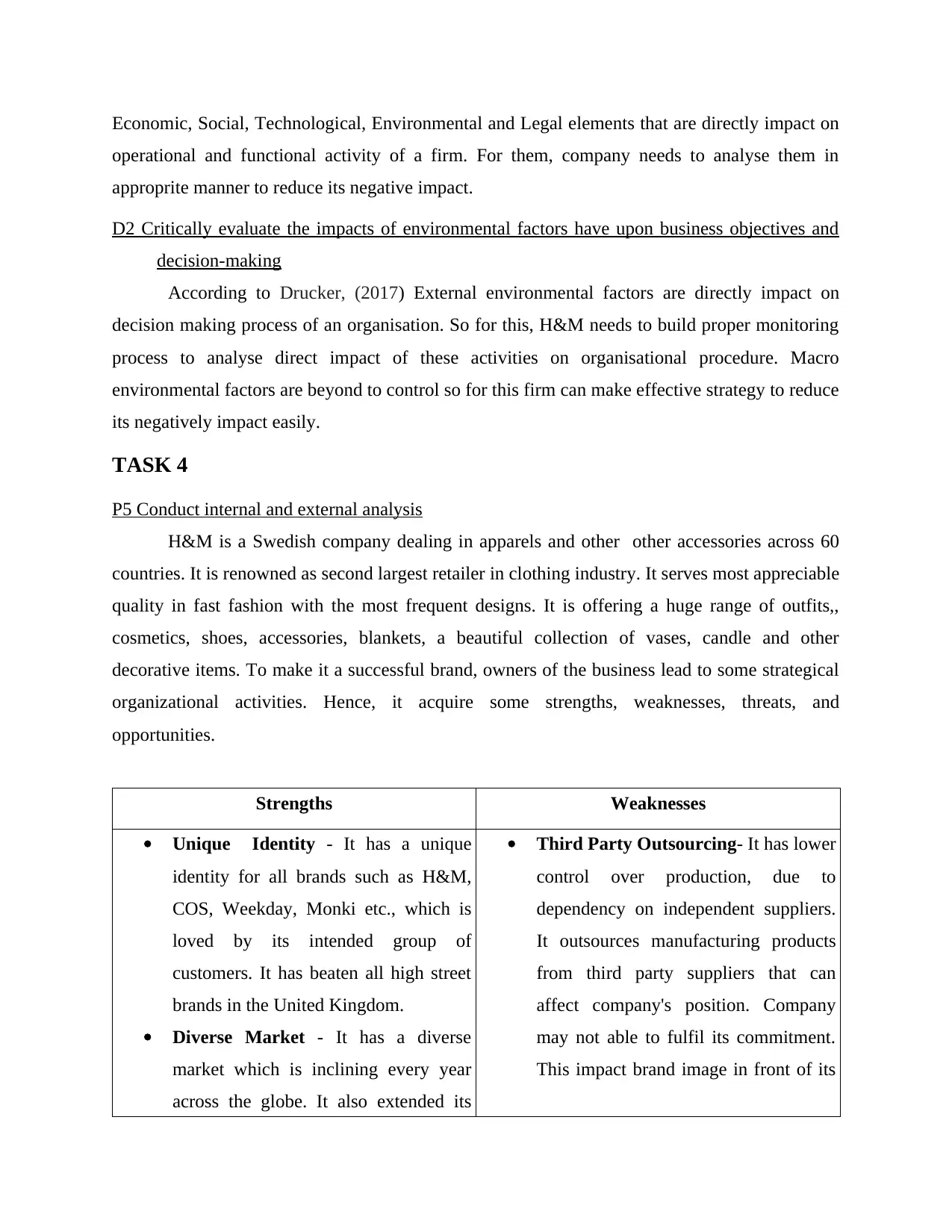
Economic, Social, Technological, Environmental and Legal elements that are directly impact on
operational and functional activity of a firm. For them, company needs to analyse them in
approprite manner to reduce its negative impact.
D2 Critically evaluate the impacts of environmental factors have upon business objectives and
decision-making
According to Drucker, (2017) External environmental factors are directly impact on
decision making process of an organisation. So for this, H&M needs to build proper monitoring
process to analyse direct impact of these activities on organisational procedure. Macro
environmental factors are beyond to control so for this firm can make effective strategy to reduce
its negatively impact easily.
TASK 4
P5 Conduct internal and external analysis
H&M is a Swedish company dealing in apparels and other other accessories across 60
countries. It is renowned as second largest retailer in clothing industry. It serves most appreciable
quality in fast fashion with the most frequent designs. It is offering a huge range of outfits,,
cosmetics, shoes, accessories, blankets, a beautiful collection of vases, candle and other
decorative items. To make it a successful brand, owners of the business lead to some strategical
organizational activities. Hence, it acquire some strengths, weaknesses, threats, and
opportunities.
Strengths Weaknesses
Unique Identity - It has a unique
identity for all brands such as H&M,
COS, Weekday, Monki etc., which is
loved by its intended group of
customers. It has beaten all high street
brands in the United Kingdom.
Diverse Market - It has a diverse
market which is inclining every year
across the globe. It also extended its
Third Party Outsourcing- It has lower
control over production, due to
dependency on independent suppliers.
It outsources manufacturing products
from third party suppliers that can
affect company's position. Company
may not able to fulfil its commitment.
This impact brand image in front of its
operational and functional activity of a firm. For them, company needs to analyse them in
approprite manner to reduce its negative impact.
D2 Critically evaluate the impacts of environmental factors have upon business objectives and
decision-making
According to Drucker, (2017) External environmental factors are directly impact on
decision making process of an organisation. So for this, H&M needs to build proper monitoring
process to analyse direct impact of these activities on organisational procedure. Macro
environmental factors are beyond to control so for this firm can make effective strategy to reduce
its negatively impact easily.
TASK 4
P5 Conduct internal and external analysis
H&M is a Swedish company dealing in apparels and other other accessories across 60
countries. It is renowned as second largest retailer in clothing industry. It serves most appreciable
quality in fast fashion with the most frequent designs. It is offering a huge range of outfits,,
cosmetics, shoes, accessories, blankets, a beautiful collection of vases, candle and other
decorative items. To make it a successful brand, owners of the business lead to some strategical
organizational activities. Hence, it acquire some strengths, weaknesses, threats, and
opportunities.
Strengths Weaknesses
Unique Identity - It has a unique
identity for all brands such as H&M,
COS, Weekday, Monki etc., which is
loved by its intended group of
customers. It has beaten all high street
brands in the United Kingdom.
Diverse Market - It has a diverse
market which is inclining every year
across the globe. It also extended its
Third Party Outsourcing- It has lower
control over production, due to
dependency on independent suppliers.
It outsources manufacturing products
from third party suppliers that can
affect company's position. Company
may not able to fulfil its commitment.
This impact brand image in front of its
⊘ This is a preview!⊘
Do you want full access?
Subscribe today to unlock all pages.

Trusted by 1+ million students worldwide
1 out of 16
Related Documents
Your All-in-One AI-Powered Toolkit for Academic Success.
+13062052269
info@desklib.com
Available 24*7 on WhatsApp / Email
![[object Object]](/_next/static/media/star-bottom.7253800d.svg)
Unlock your academic potential
Copyright © 2020–2025 A2Z Services. All Rights Reserved. Developed and managed by ZUCOL.





